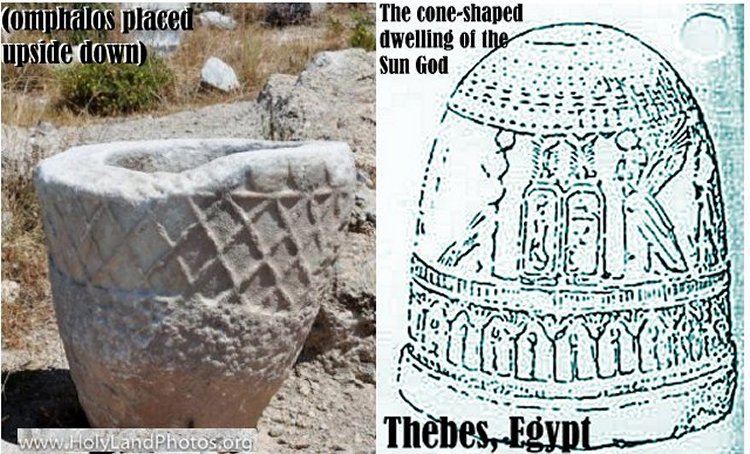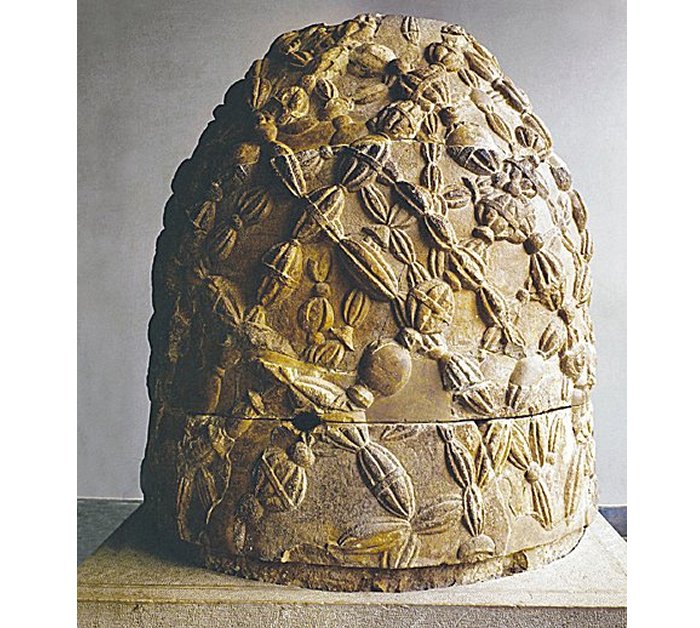A. Sutherland - AncientPages.com - Standing in the center of the archaeological complex of Delphi, few people pay attention to this sacred object of a relatively insignificant structure.
It is constructed out of a pile of circular disks, each one somewhat smaller than the one underneath.
According to Herodotus, a sacred serpent was fed honey cakes once a month at the Acropolis in Athens. These honey cakes were marked with the Omphalos
For the ancient Greeks, this object, known as the Omphalos of Delphi, represented a symbol for the 'Navel of the World.'
The Greeks later adopted the conical-shaped stone as a sacred dwelling of Apollo, their Sun God Apollo - the residence of Sun God. The holiest device - Omphalos - was used at every oracular site. The sacred stone 'Omphalos' also had a geodetic meaning - as a geodetic point of a master grid.
"The superstition of the Omphalos was widespread, similar to the serpent belief, from India to Greece. It is a boss or orb with spiral lines thought to represent serpents coiled or the electromagnetic energy encircling the globe. There are similar markings on ancient stone monuments across the world - especially at Newgrange in Ireland.
This egg-shaped stone—the very stone described by the Greek writer Pausanias, who visited Delphi in the second century A.D. The original omphalos stone, now lost, was probably an archaic cult object that supplicants draped with wreaths, resembling the wreaths carved in relief on this stone. (Erich Lessing)
Quintus Curtius also pointed out that in Africa, there were such stones with spiral lines drawn, said to be a symbol of the serpent deity.
According to Herodotus, a sacred serpent was fed honey cakes once a month at the Acropolis in Athens. These honey cakes were marked with the Omphalos." 1
The mythological story tells that the supreme Greek god, Zeus, sent two eagles from both ends of the world. These two birds began their flight simultaneously and kept flying until they met each other in the middle of the way, which was at the Omphalos.
The site, later known as Delphi, was a sacred place inhabited by the Earth Goddess Gaia (or Gaea), the great mother of all and guarded by her child, the serpent Python.
Omphalos at Delphi, Greece - probably a replica built in the 4th century BC - is a curious object and many theories have been proposed to explain the purpose of it. Image credit: - CC BY-SA 4.0
The Omphalos, probably a replica built in the 4th century BC, is a curious object, and many theories have been proposed to explain its purpose.
Some have explained it as a funnel for the fumes that caused the Oracle at Delphi to get visions; some others suggest that the stone given to Cronus by the goddess Rhea to thwart him from eating Zeus, their newborn son.
The word 'omphalos' or 'baetylus' is of Semitic origin (-Bethel). Many of these stones existed in antiquity. They were considered sacred, mainly related to the cult of some particular god, and looked upon as his abiding place or symbol.
Sometimes these stones had a more regular shape; they were formed into pillars or groups of three pillars. Such columns were sometimes placed before a shrine; others were used as mileposts and often shaped into human form.
The Omphalos of Delphi. Image credit: Юкатан -CC BY-SA 3.0
The baetylus (Bethel or Betyl) became the parent form for altars and iconic sculptures. It was one of the sacred stones that once fell from heaven and contained the power of life; after that, such heavenly treasures were used for ritual and worship.
More evidence of the stone being taken from Bethel, a city described in the Hebrew Bible, of which location, between Benjamin and Ephraim, was also confirmed by Jacob.
"And he called the name of that place Bethel: but the name of that city was called Luz at first...."(Genesis 28:19)
George Andrew Reisner, an American archaeologist of Ancient Egypt and Palestine who discovered the Omphalos at the Amun/Zeus temple, said that
Libation of Artemis and Apollo at omphalos. Red-figure lekythos by the Shuvalov Painter (?), ca. 440 BC - Image credit: - CC BY-SA 3.0
"... in the front there is an opening. Inside a cavity with a depression, reminiscent of a seat, can be detected. I could imagine that this was the seat for a small deity figurine. Around the sculpture runs a band with sculptures of figures moving towards the opening of these figures, four people are features with wings."
However, the remarkable object in Delphi is not the only Omphalos that has been discovered. Omphalos was also found at the ancient Greek oracle site of Ptoion. Its other connection is the Egyptian oasis of Siwa. The oasis, the seat of the oracle temple of Zeus Ammon), was already well-known in the time of Herodotus and even consulted by Alexander the Great. The place's Egyptian name is Sekht-am ("palm land").
To the Etruscans, the Omphalos symbolized a route to the Underworld.
Written by – A. Sutherland AncientPages.com Staff Writer
Updated on November 1, 2022
Copyright © AncientPages.com All rights reserved. This material may not be published, broadcast, rewritten or redistributed in whole or part without the express written permission of AncientPages.com
Expand for references- Philip Gardiner, 'Gateways to the Otherworld
Leeming, D. The Oxford Companion to World Mythology







